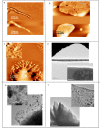DNA-nanoparticle assemblies go organic: macroscopic polymeric materials with nanosized features
- PMID: 22646980
- PMCID: PMC3408339
- DOI: 10.1186/1477-3155-10-21
DNA-nanoparticle assemblies go organic: macroscopic polymeric materials with nanosized features
Abstract
Background: One of the goals in the field of structural DNA nanotechnology is the use of DNA to build up 2- and 3-D nanostructures. The research in this field is motivated by the remarkable structural features of DNA as well as by its unique and reversible recognition properties. Nucleic acids can be used alone as the skeleton of a broad range of periodic nanopatterns and nanoobjects and in addition, DNA can serve as a linker or template to form DNA-hybrid structures with other materials. This approach can be used for the development of new detection strategies as well as nanoelectronic structures and devices.
Method: Here we present a new method for the generation of unprecedented all-organic conjugated-polymer nanoparticle networks guided by DNA, based on a hierarchical self-assembly process. First, microphase separation of amphiphilic block copolymers induced the formation of spherical nanoobjects. As a second ordering concept, DNA base pairing has been employed for the controlled spatial definition of the conjugated-polymer particles within the bulk material. These networks offer the flexibility and the diversity of soft polymeric materials. Thus, simple chemical methodologies could be applied in order to tune the network's electrical, optical and mechanical properties.
Results and conclusions: One- two- and three-dimensional networks have been successfully formed. Common to all morphologies is the integrity of the micelles consisting of DNA block copolymer (DBC), which creates an all-organic engineered network.
Figures




Similar articles
-
Sequence-Defined DNA Polymers: New Tools for DNA Nanotechnology and Nucleic Acid Therapy.Acc Chem Res. 2025 Jan 21;58(2):177-188. doi: 10.1021/acs.accounts.4c00580. Epub 2025 Jan 8. Acc Chem Res. 2025. PMID: 39772484
-
DNA block copolymers: functional materials for nanoscience and biomedicine.Acc Chem Res. 2012 Sep 18;45(9):1419-30. doi: 10.1021/ar200211a. Epub 2012 Jun 22. Acc Chem Res. 2012. PMID: 22726237 Review.
-
Polymer-Tethered Nanoparticles: From Surface Engineering to Directional Self-Assembly.Acc Chem Res. 2022 Jun 7;55(11):1503-1513. doi: 10.1021/acs.accounts.2c00066. Epub 2022 May 16. Acc Chem Res. 2022. PMID: 35576169
-
Interfacially formed organized planar inorganic, polymeric and composite nanostructures.Adv Colloid Interface Sci. 2004 Nov 29;111(1-2):79-116. doi: 10.1016/j.cis.2004.07.005. Adv Colloid Interface Sci. 2004. PMID: 15571664 Review.
-
Controlled arrangement of nanoparticle arrays in block-copolymer domains.Small. 2006 May;2(5):600-11. doi: 10.1002/smll.200500474. Small. 2006. PMID: 17193094 Review.
Cited by
-
Nanoinformatics knowledge infrastructures: bringing efficient information management to nanomedical research.Comput Sci Discov. 2013 Nov 27;6(1):014011. doi: 10.1088/1749-4699/6/1/014011. Comput Sci Discov. 2013. PMID: 24932210 Free PMC article.
References
-
- Li X, Yang X, Qi J, Seeman NCJ. Am Chem Soc. 1996. p. 6131. - DOI
Publication types
MeSH terms
Substances
LinkOut - more resources
Full Text Sources
Research Materials

